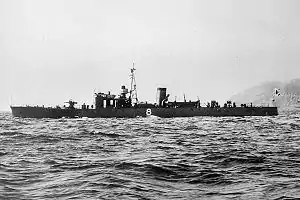CH-4-class submarine chaser
The No.4 class submarine chaser (第四号型駆潜艇,, Dai 4 Gō-gata Kusentei) was a class of submarine chasers of the Imperial Japanese Navy (IJN), serving during and after World War II. Nine vessels were built between 1937 and 1939 under the Maru 3 Programme.
 No.8 in 1938 | |
| Class overview | |
|---|---|
| Name: | No.4 class submarine chaser |
| Builders: |
|
| Operators: | |
| Preceded by: | No.3 class |
| Succeeded by: | No.13 class |
| Cost: | 1,579,000 JPY |
| Built: | 1937 – 1939 |
| In commission: | 1938 – 1960 |
| Planned: | 9 |
| Completed: | 9 |
| Lost: | 7 (or 6)[1] |
| Retired: | 2 (or 3)[1] |
| General characteristics | |
| Type: | Submarine chaser |
| Displacement: |
|
| Length: |
|
| Beam: | 5.6 m (18 ft 4 in) |
| Draught: | 2.1 m (6 ft 11 in) |
| Propulsion: | 2 × Kampon Mk.22 Model 6 diesels, 2 shafts, 2,600 bhp |
| Speed: | 20.0 knots (23.0 mph; 37.0 km/h) |
| Range: | 2,000 nmi (3,700 km) at 14 kn (16 mph; 26 km/h) |
| Complement: | 59 |
| Armament: |
|
Design
Developed under project number was K7, the No.4 class submarine chaser was an improved variant of the No.3 class, with increased freeboard. Other general features were the same as the No.3 class. Their design was elaborate, because the Navy Technical Department (Kampon) devoted itself to making them small. However, the design was not able to accept additional anti-aircraft guns and depth charges.
Ships in class
| Ship # | Ship | Builder | Laid down | Launched | Completed | Fate |
| 62 | No.7[2] | Tsurumi Iron Works | 30 October 1937 | 10 June 1938 | 15 November 1938 | Sunk by aircraft at east of Car Nicobar on 11 April 1945. |
| 63 | No.8 | Tama Shipyards | 10 January 1938 | 9 August 1938 | 30 November 1938 | Sunk by HMS Trenchant and HMS Terrapin at Strait of Malacca on 4 March 1945. |
| 64 | No.4 | Ōsaka Iron Works, Sakurajima Factory | 19 January 1938 | 13 September 1938 | 28 December 1938 | Struck a naval mine and sank at Surabaya on 13 August 1945. |
| 65 | No.5 | Mitsubishi, Yokohama Shipyard | 25 January 1938 | 28 July 1938 | 6 December 1938 | Scuttled by Royal Navy off Singapore on 11 July 1946. Decommissioned on 10 August 1946. |
| 66 | No.11 | Tsurumi Iron Works | 19 January 1938 | 28 June 1938 | 2 February 1939 | Sunk by aircraft at west of Buka Island on 6 November 1943. |
| 67 | No.12 | Tama Shipyards | 15 July 1938 | 8 February 1939 | 30 April 1939 | Probably sunk by USS Bluegill east of Mindanao on 13 August 1944.[1] Decommissioned on 30 September 1945. |
| 68 | No.10 | Ōsaka Iron Works, Sakurajima Factory | 16 September 1938 | 31 January 1939 | 15 June 1939 | Aground at Angaur on 2 May 1944. Later scuttled. |
| 69 | No.9 | Mitsubishi, Yokohama Shipyard | 10 May 1938 | 15 October 1938 | 9 May 1939 | Decommissioned on 20 December 1945. Surrendered to Republic of China on 3 October 1947, and renamed Haida. Renamed Fuling (PC-107) in January 1951. Renamed Minjiang in 1954. Decommissioned in 1960. |
| 70 | No.6 | Tsurumi Iron Works | 5 July 1938 | 6 February 1939 | 20 May 1939 | Heavy damaged by aircraft at Palau on 30 March 1944. Later sank in shallow water. |
Footnotes
- Another opinion: The No.12 was survived war at Palau.
- Submarine chaser No.7 (第7号駆潜艇, Dai 7 Gō Kusentei). The same shall apply hereinafter.
Bibliography
- Ships of the World special issue Vol.45, Escort Vessels of the Imperial Japanese Navy, "Kaijinsha"., (Japan), February 1996
- The Maru Special, Japanese Naval Vessels No.49, Japanese submarine chasers and patrol boats, "Ushio Shobō". (Japan), March 1981
- "Japanese Subchasers". Combinedfleet.com.
This article is issued from Wikipedia. The text is licensed under Creative Commons - Attribution - Sharealike. Additional terms may apply for the media files.